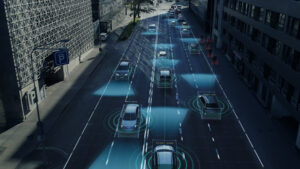
Trade groups urge Buttigieg to advance autonomous driving program
By onAnnouncements
More than a dozen organizations are calling on Transportation Secretary Pete Buttigieg to advance a proposed program that would expedite the deployment of self-driving cars.
In a letter sent to Buttigieg earlier this month, the coalition of trade groups urged him to bring forward a notice of proposed rulemaking on the Automated Driving System (ADS)-Equipped Vehicle Safety, Transparency and Evaluation Program (AV STEP).
Under AV STEP, the National Highway Transportation Safety Administration (NHTSA) would consider applications for deploying compliant and noncompliant ADS vehicles, with the latter subject to review.
In their letter, program advocates said the AV industry is at a “critical juncture” and requires strong leadership from the U.S. Department of Transportation.
“We urge the Department to use existing authorities to assert its jurisdiction over the design, construction, and performance of motor vehicles, including those deploying emerging technology,” the letter says. “AV STEP could hasten the deployment of vehicles whose designs require exemptions from the current Federal Motor Vehicle Safety Standards and introduce a new era of accessibility and vehicle safety for the American public.”
The letter said by advancing AV STEP, NHTSA could gain additional data and insights to accelerate its rulemaking and standard setting on AVs.
“AVs are already having a positive impact on communities,” the letter says. “Upon landing in Phoenix, you can hail a robotaxi at the airport to get to your destination. California residents can order autonomous meal deliveries, and in states like Texas and Arkansas, major retailers are transporting freight via autonomous trucks.”
The letter did not mention General Motors’ Cruise autonomous taxis, which were suspended by the California Department of Motor Vehicles (DMV) in October, in part due to safety and also because the department said Cruise had “misrepresented” information related to the vehicles’ safety.
“Public safety remains the California DMV’s top priority, and the department’s autonomous vehicle regulations provide a framework to facilitate the safe testing and deployment of this technology on California public roads,” the department said at the time. “When there is an unreasonable risk to public safety, the DMV can immediately suspend or revoke permits.”
The suspension came days after Cruise said it was working with local emergency responders and police to address concerns related to a collision between a robotaxi and a firetruck in August.
Instead, the letter focused on the positive aspects of AVs and how they could benefit those living in rural areas or living with physical disabilities. It said self-driving vehicles could benefit the public by improving road safety, enhancing accessibility, optimizing supply chains, and lessening the transportation sector’s environmental impact.
The letter was signed by the Autonomous Vehicle Industry Association, ACES Mobility Coalition, Alliance for Automotive Innovation, American Traffic Safety Services Association, and American Trucking Association.
Other signatories included the U.S. Chamber of Commerce, AUVSI Chamber of Progress Coalition for Reimagined Mobility, Consumer Technology Association Motor & Equipment Manufacturers Association, National Federation of the Blind, NetChoice, and Partners for Automated Vehicle Education. The SAVE Coalition, Securing America’s Future Energy, TechNet, and United Spinal Association.
“The Department’s support for AV development is crucial to maintain our nation’s competitive edge and secure our position as a global leader,” the letter says. “The U.S. stands at a critical juncture in the AV race, with countries like China aggressively investing and advancing the technology.
“USDOT’s continued guidance and support will keep the United States at the forefront of AV development and deployment. …We cannot lose sight of the need to improve transportation in the United States and ensure the immense benefits of autonomous technology are realized.”
Meanwhile, researchers are working to determine how to train AVs to make good decisions by better understanding what people consider “moral and immoral” behind-the-wheel behaviors, according to a new Science Daily report that described such scenarios as the “trolley problem.”
“The trolley problem presents a situation in which someone has to decide whether to intentionally kill one person (which violates a moral norm) in order to avoid the death of multiple people,” Dario Cecchini, first author of a paper on the work and a North Carolina State University postdoctoral researcher, told the outlet. “In recent years, the trolley problem has been utilized as a paradigm for studying moral judgment in traffic.
“The typical situation comprises a binary choice for a self-driving car between swerving left, hitting a lethal obstacle, or proceeding forward, hitting a pedestrian crossing the street. However, these trolley-like cases are unrealistic. Drivers have to make many more realistic moral decisions every day. Should I drive over the speed limit? Should I run a red light? Should I pull over for an ambulance?”
With a lack of data, researchers developed a way to collect information through virtual reality-type experiments on how people behave in non-emergency situations, like whether they’d run a red light to get a child to school on time.
The research model shows the outcomes of what might happen by running the light (causing an accident) versus stopping at a yellow and making it to school on time.
For this work, the researchers built on something called the Agent Deed Consequence (ADC) model, which posits that people take three things into account when making a moral judgment: the agent, which is the character or intent of the person who is doing something; the deed, or what is being done; and the consequence, or the outcome that resulted from the deed.
Researchers created eight different versions of each traffic scenario, varying the combinations of agent, deed, and consequence.
“The goal here is to have study participants view one version of each scenario and determine how moral the behavior of the driver was in each scenario, on a scale from one to 10,” Cecchini said.
“This will give us robust data on what we consider moral behavior in the context of driving a vehicle, which can then be used to develop AI algorithms for moral decision-making in autonomous vehicles.”
Images
Featured image courtesy of gorodenkoff/iStock
